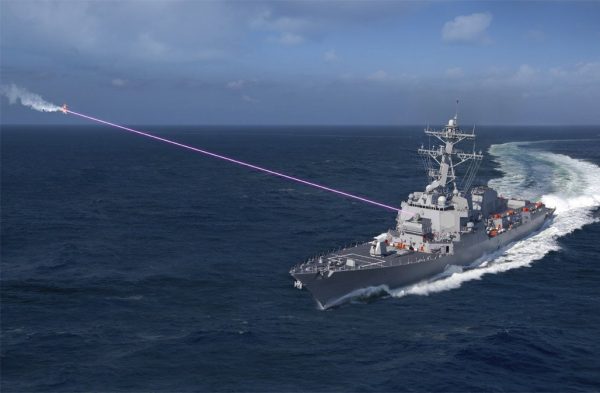Pentagon Shifts Focus on Directed Energy Weapons Technology – USNI News

Artist’s concept of a HELIOS laser system aboard a U.S. destroyer. Lockheed Martin Image
ARLINGTON, Va. – The Department of Defense is focusing its directed energy weapons research on technologies ready to field now, placing on the backburner plans to create more complex space-based technology, the Pentagon’s head of research said on Wednesday.
Exploring the usefulness of directed energy, specifically figuring out how to increase the wattage of these weapons, is the Pentagon’s focus now, Michael Griffin, the undersecretary of defense for research and engineering, said during a keynote address at the 2019 Defense News conference. In practical terms, this means the Pentagon wants technologies ready to deploy in the near-term and is shelving plans to develop systems that are years away from initial testing.
“We’re looking at high powered microwaves,” Griffin said. “We’re deferring work on neutral particle beams indefinitely. It’s just not near-enough term.”
Griffin’s comments Wednesday signal a narrowing focus for the Pentagon’s directed energy development. In March, the Pentagon was fully behind developing a space-based neutral particle beam, a directed energy project that has its roots in the 1980s.
“The neutral particle beam is a game-changing space-based directed-energy capability for strategic and regional missile defense. MDA will design, develop and conduct a feasibility demonstration of a first stage accelerator subsystem,” according to the Fiscal Year 2020 Research Development Test and Evaluation department-wide project justification for the Missile Defense Agency.
The Pentagon planned neutral particle beam spending of $34 million in the next fiscal year and up to $380 million during the next four years. The funding would be used to conduct detailed systems engineering of the technology. The idea is to use neutral particles to bombard incoming targets with enough energy to disrupt, incapacitate or kill the threat, according to the FY 2020 project justification.
Instead, Griffin said his preference now is to invest in directed energy capabilities that can be fielded now, so researchers can get to figuring out how to improve them.
“We’re focusing on nearer-term uses of directed energy, particularly lasers of higher power than we currently have,” Griffin said.
The Navy, for example, plans to install a High Energy Laser and Integrated Optical-dazzler with Surveillance (HELIOS) weapon system aboard a West Coast-based Arleigh Burke-class Flight IIA destroyer in 2021, according to comments made in March by Rear Adm. Ron Boxall during the Booz Allen Hamilton and CSBA Directed Energy Summit 2019.
The Pentagon is looking for a boost in directed energy capabilities, Griffin said. Current directed energy technology operates in the realm of tens of kilowatts, but to be useful Griffin said these weapons need to run in at least the hundreds of kilowatts realm.
“I think the key – my own personal opinion, having been involved in directed energy for three decades – my own opinion is we need to get systems built and out onto weapons platforms so we can see what they do, how they do it,” Griffin said. “We need to better understand the lethality of such systems. We need to understand things like heat control, and we need to know how to scale them up in practical ways.”
The HELIOS program is part of a larger Navy laser weapon strategy that would feed lessons learned back into research and then fielding of more powerful weapons.
The Pentagon’s directed energy signals also appear to be received by the defense industry. Demand for directed energy weapons was among the justifications cited by officials with Raytheon and United Technologies when explaining the reasoning behind their planned deal to combine companies.
If shareholders and federal regulators approve the United Technologies purchase of Raytheon, the cash flow from the combined operations would fuel the development of directed energy weapons, the chief executives of both firms said during their second-quarter company conference calls with analysts in July.






